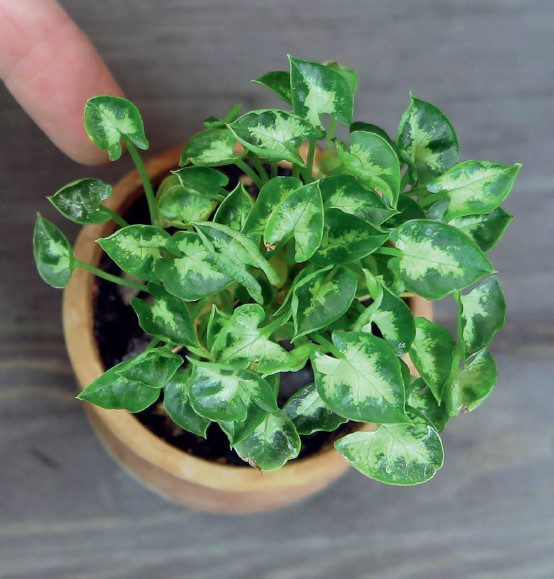Amazing Dwarf Arrowhead Plant
When I discovered this micro-miniature arrowhead plant, my mind was a little bit blown.
It is the cutest little houseplant. ‘Mini Pixie’ looks just like any standard juvenile arrowhead plant but with heart-shaped leaves the size of your fingernail.

Creamy white variegated centers accent the leaves.
The species is native to Latin America, ranging from Mexico to Bolivia. However,
plants have naturalized in the southern continental U.S. and Hawaii, and the West Indies.
Juvenile plants grow in a contained clump.
As plants mature, stems begin to elongate, produce aerial roots, and creep along the ground or climb up neighboring plants or other supports.
Size: ‘Mini Pixie’ typically stays in a clump form only 2 to 3 inches (5 to 8
cm) tall and wide.
It can produce tiny running stems as it matures, but it is
less apt to do so than its parent Syngonium species.
The tiny heart-shaped leaves measure ½ to ¾ of an inch (1.2 to 1.9 cm).
Care: Syngonium ‘Mini Pixie’ is a versatile little aroid you can grow in
varying conditions.
Plants have low to medium indirect light needs and prefer the equivalent of an east-facing window but will tolerate lower and higher light levels.
More light will keep plants more compact; less light will result in a more elongated clump.
Plants do well in normal home humidity levels.
If the leaf edges seem to be drying a bit due to low humidity, mist the foliage a few times per week.
Plants grow happily in 2- to 3-inch (5 to 8 cm) pots with several waterings per week.
While they like moisture, Syngonium does not like “wet feet,” so use a lightweight potting mix for indoor plants and consider adding some coir to keep moisture more uniform.
Plants can dry a bit between waterings on your windowsill; however, you also can plant ‘Mini Pixie’ and other mini Syngonium into terrariums.
Flowering
Most plant parents stick to foliage plants indoors because blooming plants can seem trickier to grow or need too much light.
However, certain tiny bloomers are well-suited to indoor growing conditions, especially if you provide supplemental grow lighting.
Many of my favorite tiny bloomers hail from the gesneriad category. Gesneriads as a group include plants such as African violets, gloxinia, and cape primrose.
Many small succulents also put on impressive blooms; however, most succulents are primarily grown for their foliage.
Micro orchids are the pinnacle of my tiny plant obsession. There are thousands of miniature and micro orchids to add to your collection, with an abundance to choose from available in the plant trade.
That said, micro orchids can be tricky to grow for beginners. Many micro orchids are
recommended for growing inside terrariums, as they need consistent moisture around their aerial roots and higher relative humidity.
However, beginners may find terrarium conditions challenging, and many tiny orchids can quickly rot from excess moisture and inadequate aeration.
The micro-orchid species listed here in the windowsill section can be grown in terrariums or orchidariums, but they are also tolerant of open environment culture.
Arrowhead Plant Care
Arrowhead plant care is relatively straightforward. The arrowhead plant prefers drying out between watering. Even though the plant likes some moisture, it should not be too wet, leading to root rot.
It likes temperatures between 60 and 75 F. (16 and 24 C.) but can tolerate a broader range if required. Appropriate arrowhead plant care needs a moist environment, specifically over dry winter periods.
Spray the plant daily or put its pot on a tray with pebbles and water to heighten humidity for perfect growth.
The arrowhead plant may be fertilized each month with a regulated fertilizer. The shape of leaves changes as the plant matures, beginning as an arrowhead shape and then evolving into three to five finger-like sections.
Leaves are generally green in color, but many varieties comprise variegated leaves of contrasting shades.
The densely variegated varieties demand bright, filtered light.
Moderate light is the norm for solid green types or ones with less variegation.
Hold them aside from direct sunlight exposure, as it will result in the arrowhead plant char or bleach. The arrowhead plant can tolerate low light levels occasionally.


























Comments are closed.